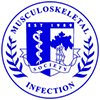Authors: Antoci Jr, Valentin*; Adams, Christopher S.; Hoffsommer, Hellen M.; Binoy, Jose; King, Samuel B.; Freeman, Theresa A.; Parvizi Javad; Shapiro, Iriving M; Hickok, Noreen J
Title: Vancomycin-Modified Rods Inhibit Bacteria Despite Serum Coverage
Addresses: 1015 Walnut St. 501, Philadelphia, PA 19107
Purpose: We have hypothesized that a surface modified with covalently-bound vancomycin will be bactericidal, thus preventing bacterial attachment and biofilm formation. We have tested the activity of such a surface against S. epidermidis.
Methods: Modification of Ti alloy Passivated Ti90Al6V4 (Ti, Goodfellow) surfaces were aminopropylated with aminopropyl-triethoxysilane followed by Fmoc coupling of two aminoethoxy-ethylacetic acid linkers and vancomycin. Implant coverage. Rods were incubated in FBS, washed and stained with antibodies to Vanc, Alb, and fibronectin (FN). Indirect immunofluorescence. Rods were incubated with mouse anti-Vanc IgG, goat anti-FN IgG, or rabbit anti-BSA IgG (1:500), 2h, followed by AlexaFluor 594-coupled donkey anti-mouse IgG (1:300), AlexaFluor 647-coupled donkey anti-rabbit IgG, AlexaFluor 488-coupled donkey anti-goat IgG (1:500, Molecular Probes), 1h. Bactericidal Activity. Weighed control and Ti-Vanc were sterilized with 70% ethanol, 30 min, washed 5X with PBS, and incubated with 104 cfu of S. epidermidis under static conditions. At 2, 5, 8, 12, and 30 h, six rods were removed, washed 5X with PBS, and three rods used for bacterial adhesion/viability and three used for total bacterial numbers. Adherent bacteria were suspended by sonication in 1 ml 0.3% Tween 80 in TSB, 5 min, and vortexing, 5 min. Bacterial counts were determined by triplicate plating of serial dilutions on TSB agar (countable range = 30 - 300 cfu/plate). Total bacterial numbers were expressed as a function of pin weight. Rods were washed 6X with PBS to remove non-adherent bacteria, stained with the Live/Dead BacLightTM Viability Kit (Molecular Probes), 15 min.
Results: On Ti-Vanc rods, only small areas of fluorescence are apparent, suggesting that Vanc is potently inhibiting bacterial colonization. In contrast, control Ti rods are extensively colonized, as evidenced by intense green staining, and this colonization increases with time. Numbers of adherent S. epidemidis were also determined by direct counting, with Ti-Vanc rods showing significantly fewer adherent bacteria than control rods. Because, in a physiological environment, implants will be coated with serum proteins, we next asked if Vanc coverage affected the adsorption of serum proteins and if this protein affected Vanc activity. After incubation with FBS, both rods are coated with FN and Alb. Interestingly, the signal for these proteins is more intense on Ti-Vanc rods possibly indicating increased coverage. Importantly, serum incubation did not significantly alter the intensity of the Vanc fluorescence, suggestingthat this coverage with serum proteins did not alter Vanc accessibility. To test this, Ti-Vanc rods were incubated in FBS or DIH2O for 24h and challenged with S. epidermidis. Ti-Vanc potently inhibits S. epidemidis colonization, confirming the activity of the Ti-Vanc even when coated by serum proteins.
Discussion: We have described a surface modification that allows Ti rods to resist colonization and ultimately biofilm formation by large numbers of contaminating S. epidermidis, despite the acquisition of an abundant FN and Alb coating, as would happen during surgical insertion of the implant. Because these surfaces retain their antibiotic, problems of tissue toxicity and bacterial resistance are minimized. Such surfaces hold great promise for the prevention and treatment of periprosthetic infections.

